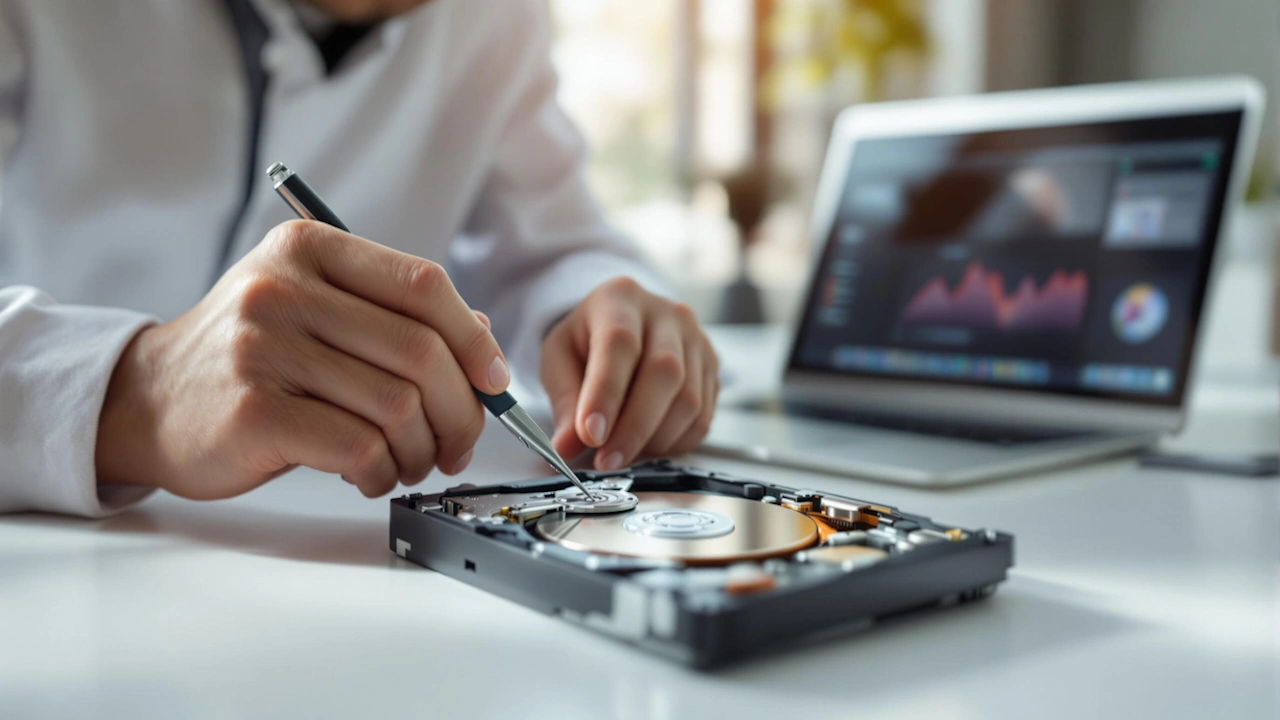Computer Recovery
Data Recovery Guide: Saving Files from a Failed Hard Drive
Data Recovery Guide: Saving Files from a Failed Hard Drive
Hard drive failure can strike unexpectedly, risking your important files. This guide simplifies data recovery, helping you retrieve lost data and prevent future loss. Here’s what you’ll learn:
- Identify the Problem: Distinguish between logical (software) and physical (hardware) failures.
- Recover Data: Use tools like EaseUS, Recuva, or Disk Drill for logical issues. For physical damage, disconnect the drive and consult professionals.
- Prevent Future Loss: Follow the 3-2-1 backup rule and maintain your drives with regular checks.
Key Tip: Always stop using a failing drive immediately to avoid permanent damage. Whether it’s DIY recovery or professional help, acting quickly can save your data.
How to Recover Data from a Hard Drive that Won’t Boot
Step 1: Check Your Hard Drive Failure Type
To choose the best recovery approach and prevent further damage, figure out if your hard drive issue is logical or physical. Pay attention to the signs that help distinguish between the two.
Signs of Logical Failure
Logical failures are caused by software problems, not physical damage. Look out for these clues:
- Files vanish unexpectedly from folders.
- Error messages pop up when accessing certain directories.
- The operating system doesn’t recognize the drive.
- File names or extensions appear corrupted.
- The drive shows up as unformatted.
Signs of Physical Failure
Physical failures involve hardware damage and need special care. Watch for these red flags:
| Warning Sign | What It Means | What To Do |
|---|---|---|
| Clicking or grinding noise | Possible damage to read/write heads or platters | Stop using the drive immediately. |
| Drive not spinning | Likely motor or circuit board failure | Keep the drive powered off. |
| Overheating | Mechanical or electrical problems | Remove the drive from the system. |
| Intermittent detection | Potential connection or circuit issues | Avoid reconnecting repeatedly. |
Basic Diagnostic Tools
Use these tools to confirm what’s wrong with your drive:
-
S.M.A.R.T. Analysis
Tools like CrystalDiskInfo or HDDScan can monitor drive temperature, error rates, and bad sectors. -
Windows Check Disk Utility
Run the ‘chkdsk’ command in the Command Prompt to scan for file system errors and bad sectors. -
Third-Party Diagnostics
Software like Disk Drill offers detailed scans to pinpoint hard drive problems.
Step 2: Fix Logical Drive Failures
To recover data from a logical drive failure, you’ll need reliable recovery software and some careful preparation.
Recovery Software Options
Data recovery software helps retrieve lost files from damaged or inaccessible drives. Here’s how to use some popular tools:
EaseUS Data Recovery Wizard
Connect the drive with a USB-to-SATA adapter, install EaseUS on a working computer, and perform a deep scan. Its AI-driven engine can recover files from formatted or virus-affected drives.
Recuva
Recuva supports FAT, exFAT, and NTFS file systems. Its portable version works without installation, making it ideal for urgent situations.
| Software | Best For | Limit | Price |
|---|---|---|---|
| EaseUS | Advanced recoveries | Unlimited | $69.95/month |
| Recuva | Basic file recovery | Unlimited | Free |
| Disk Drill | Multiple devices | 500MB (free) | Free/$89 Pro |
Safety Tips Before Recovery
Take these precautions to avoid further damage:
- Create a backup image of the failing drive using byte-to-byte copying.
- Recover files to a different drive to avoid overwriting the original data.
"Creating a byte-to-byte backup image allows for the recovery process to proceed without further risking the original drive’s integrity. This is particularly useful if the drive is in a fragile state and may disconnect frequently during the recovery process."
If these steps don’t solve the problem, try some straightforward troubleshooting.
Quick Fixes for Software Problems
Check Connections
Loose or faulty cables can sometimes cause drive issues. Double-check and reseat all connections, especially SATA and power cables.
Run CheckDisk
Use Windows PowerShell as an administrator to run the CheckDisk utility. This tool scans for and repairs file system errors. On Windows 11, you can use Terminal (Admin) instead.
System Restore
If System Restore is available, roll back your system to a point before the drive issues started. This can fix software-related problems without requiring full data recovery.
Step 3: Deal with Physical Drive Damage
If diagnostics confirm physical damage to your drive, follow these steps to protect your data. Handling physical damage requires specialized tools and expertise to avoid permanent data loss.
Prevent Further Damage
The first step is to disconnect the power and data cables immediately. This helps avoid worsening the damage.
Avoid these common mistakes:
| Action | Risk |
|---|---|
| Opening the drive case | Dust or debris can contaminate internal components |
| Using recovery software | Can strain failing parts, causing more harm |
If these precautions don’t help, it’s time to seek professional assistance.
Signs You Need Professional Help
Certain symptoms indicate the need for expert intervention. Look out for:
- Physical signs: Clicking or grinding noises, a burning smell, unresponsiveness, or visible damage from drops or impacts.
- Critical indicators: Exposure to water or fire, sudden failure after a fall, or a completely unresponsive drive.
Choosing Professional Recovery Services
When a drive shows severe physical damage, professional recovery is often the best option. Experts use cleanroom environments and advanced tools to retrieve data, even from badly damaged drives. Companies like Seagate Recovery Services specialize in such cases.
If you decide to send your drive for recovery, follow these transport tips to avoid further harm:
Safe Transport Tips
- Place the drive in an anti-static bag.
- Use shock-absorbing materials for packaging.
- Keep the drive horizontal during shipping.
- Avoid exposing the drive to extreme temperatures.
Keep in mind, recovery costs can vary based on the level of damage and the complexity of the process. While professional services may seem expensive, they are often the safest way to recover your data without risking further loss.
Step 4: Stop Future Data Loss
After recovering your data, the next step is protecting it from being lost again. Use reliable methods to safeguard your files and ensure they stay secure.
Backup Strategies
The 3-2-1 backup rule is a solid approach to keeping your data safe:
- Local Backup: Save copies to external drives using tools like Windows Backup or Time Machine.
- Cloud Storage: Sync your files to cloud services such as Google Drive or OneDrive.
- Offline Archive: Maintain periodic backups on external hard drives or tape drives for added security.
Set up automated backups to make sure your data is protected consistently without needing constant attention.
Tips for Maintaining Your Drives
Taking care of your storage drives helps them last longer and reduces the risk of failure:
- Perform CheckDisk scans every month to catch potential issues early.
- Keep an eye on drive temperatures and ensure your system has proper airflow.
- Clean your computer’s vents every few months to prevent overheating caused by dust buildup.
Pairing regular maintenance with quality hardware can make a big difference in drive performance and longevity.
Choosing Reliable Storage Hardware
Selecting dependable storage devices is just as important as maintaining them. Here are some solid options:
| Drive Type | Recommended Brand | Key Features |
|---|---|---|
| SSD | Samsung 870 EVO | Dynamic Thermal Guard |
| HDD | Western Digital Black | Vibration Protection |
| External | Seagate Backup Plus | Hardware Encryption |
For advanced protection, look into NAS (Network Attached Storage) systems. These devices not only automate backups but also use RAID configurations to guard against single-drive failures, offering an extra layer of security for your data.
Summary: Data Recovery Steps
Quick Problem Identification
Spotting issues early can make all the difference. Use tools like S.M.A.R.T. to detect warning signs such as unusual clicking sounds, system crashes, or corrupted files. Acting swiftly increases the likelihood of a successful recovery. Once you’ve identified the issue, choose a recovery method that fits the problem.
Choosing the Best Recovery Method
The right recovery approach depends on the situation. For logical problems like accidental file deletions or formatting errors, recovery software can often do the trick. Tools like Recuva, Disk Drill, and EaseUS Data Recovery Wizard are popular options for these cases. On the other hand, if you notice grinding noises or suspect physical damage, avoid DIY fixes. Continuing to use the drive could worsen the damage. Instead, turn off the drive immediately and consult a professional data recovery service. After retrieving your data, focus on steps to prevent future losses.
Basics of Data Protection
Avoid future data loss by keeping an eye on your drive’s health and setting up automated backups. Install recovery tools on a separate drive and have a bootable USB with recovery software ready to go. These simple precautions can save you a lot of trouble down the line.
FAQs
Here are clear answers to common questions about hard drive data recovery.
What steps should I take to recover data from a failed hard drive?
Start by connecting the hard drive using a compatible adapter. Install data recovery software like EaseUS Data Recovery Wizard or Disk Drill on a different drive to avoid overwriting data. Perform a deep scan to locate lost files. Once the scan is complete, preview the recoverable files and save them to another drive.
Is it possible to recover data from a dead hard drive?
Recovery depends on the type and extent of the damage. For issues like accidental formatting, software corruption, or virus attacks (logical failures), specialized software often works well. But if the drive has physical damage – like from fire, water, or mechanical failure – professional services may be necessary. Certified providers like TuniLab can attempt recovery in controlled environments, though success rates vary.
How can I recover data from an unresponsive hard drive?
First, create a byte-to-byte backup image of the drive to avoid further damage. Use tools such as R-Studio ($79.99) or Disk Drill ($89) to scan the backup image instead of the original drive. These tools analyze the drive’s structure and try to rebuild the file system. Once the recovery process is complete, review the recovered files and save them to a secure location on a different drive.
| Recovery Software | Price | Best For |
|---|---|---|
| Disk Drill | $89 (lifetime) | Beginners, easy-to-use interface |
| R-Studio | $79.99 | Advanced users, complex cases |
| EaseUS Data Recovery | $119.95/year | Broad file system compatibility |

